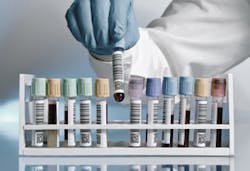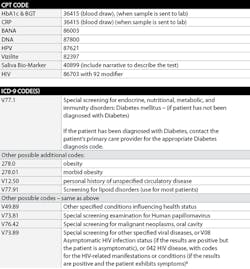Are we doing enough? The "how to" of medical coding for screenings performed in dental practices
by Marianne Harper
The majority of dental practices diagnose caries and periodontal disease through the use of explorers and periodontal probes. We should be asking if there are better methods for accurate diagnosis. Medical practice staff would never treat a patient without determining if they are treating bacteria or a virus. In dentistry, we should be differentiating between aspirin sensitivity, blood dyscrasias, other diseases, fungus, yeast, or a cyst, so bacteriologic tests should be performed.1
Over the last decade, dentistry has evolved to more actively become the field of oral medicine. We realize that dentistry can play a key role in our patients' overall body health, especially where diabetes is concerned. The National Health and Nutrition Examination Survey (2003-2004) determined that 93% of test subjects who had periodontal disease were considered to be at high risk for diabetes and should be screened for diabetes.2 Also, it's been estimated that 5.7 million Americans with diabetes were undiagnosed in 2007, with the number expected to increase dramatically in coming years.3
Couple these statistics with the fact that the majority of patients who keep their recare schedules with their dental practices are probably seen by their dentists more frequently than by their primary care physicians.4 You can see that there is a huge opportunity for dental practices to add certain types of medical screenings to their procedure mix not only to better serve patients' health, but also to increase productivity and profit for the practice. Dental practices that offer these screenings will fit the model of cutting-edge health care.
There are quite a few screenings that can be performed in a dental practice. They are:
Diabetes related
- HbA1c - Glycated hemoglobin – a form of hemoglobin that is measured primarily to identify the average plasma glucose concentration over prolonged periods of time
- BGT – blood glucose testing
Periodontal related – Infection and inflammation
- C-reactive protein (CRP) – a general marker for inflammation and infection
- BANA – for bacterial periodontal pathogens or their byproducts and aids in the diagnosis of periodontal disease
- DNA – screens for the presence of specific pathogens or for patient susceptibility of periodontal disease and tooth decay
Cancer screening
- Oral HPV testing – there is increasing evidence that oral infection with HPV, particularly with high-risk genotypes, is a significant independent risk factor for oral squamous cell carcinoma
- Chemiluminescent oral cancer screening (e.g., ViziLite)
- Saliva biomarker test – measures three specific biomarkers that play a role in cancer development in the oral cavity. This is a noninvasive saliva test that can detect biomarkers across a range of cancers in the oral cavity, including cancers of the tongue, floor of the mouth, cheek lining, gingiva, palate, salivary glands, and tissues that line the mouth and lips.5
Acquired immune deficiency syndrome
- Rapid HIV – Oral fluid HIV screening
Screenings such as these may be covered by a patient's medical insurance plan, and if they are, you can help a patient afford them by filing a cross coded claim. Dental-medical cross coding is becoming more necessary in dental practices for many medically necessary dental procedures, and these screenings may also be included. In order to file a cross coded medical claim you will need to deal with three things – procedure codes (CPT codes), diagnosis codes (ICD-9 codes), and the CMS-1500 (08/05) claim form.
With regard to procedure codes, there are CPT codes for these screenings. However, keep in mind that these codes do not guarantee coverage. Some carriers may pay while others may not pay for the same type of screening. Some carriers will accept a CDT code if it applies to the screening. Always inquire and if a carrier does cover it, then the CDT code can be used on the medical claim form. It's different from filing dental claims in that you will also need to choose diagnosis codes to explain the patient's condition and why the screening was performed.
Let's look at the more common codes required for these different screenings.
There will be some concerns when you're considering adding these screenings. One question is who would administer the screenings. Some states do not allow hygienists to administer certain tests, so you need to check your state laws to find out. Practices also need to be concerned about dealing with patients' reactions, and the staff's ability to provide counseling when giving patients test results. Some states have HIV testing laws that prohibit dental practices from performing HIV testing. A Clinical Laboratory Improvement Amendment (CLIA) application may need to be obtained for some tests. Check out these areas before implementing any of these screenings.
Implementing some or all of these screenings can make a tremendous difference in your practice. Patients will realize that you truly care about their health, which will result in patients having more confidence in your practice. This will result in greater case acceptance. These patients will also verbally market your practice. Implementing screenings can be a great win-win situation for your patients and your practice.
For more information on how to cross code, visit my website at www.artofpracticemanagement.com for products and services to help you with this process. Cross coding is more challenging than dental coding, and even simple mistakes in claim form completion can result in denials.
References available upon request
Marianne Harper is the owner of The Art of Practice Management, a dental practice management consulting company. Revenue and collection systems, business office systems, and dental-medical cross-coding are her specialties. Marianne is a member of The Academy of Dental Management Consultants, The Professional Management Consultants Association, Speaking Consulting Network (SCN), and CareerFusion. She is a published author and a well-respected speaker. You can reach her through www.artofpracticemanagement.com or through the SCN website, www.speakingconsultingnetwork.com
Past DE Issues


